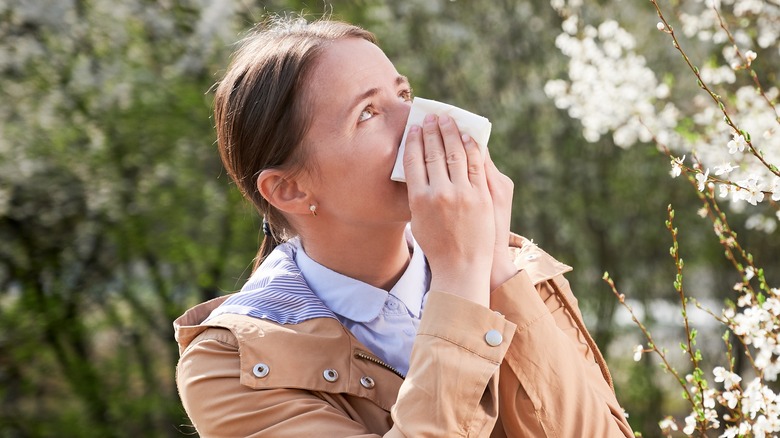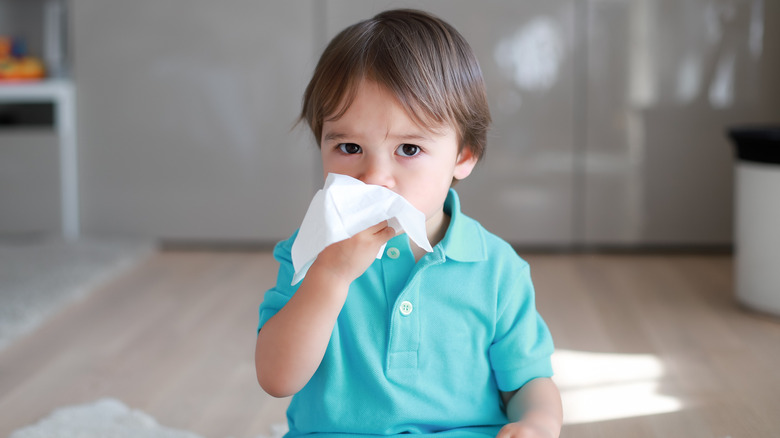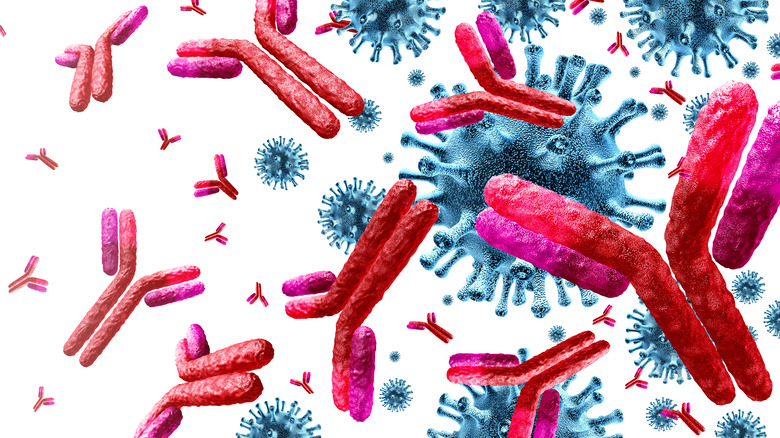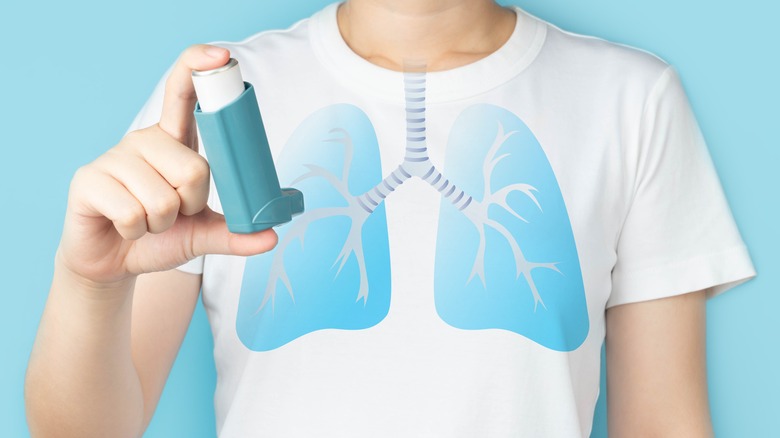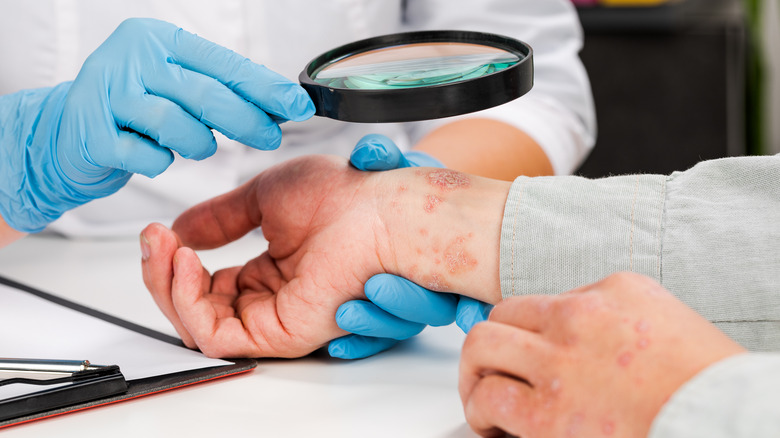When You Have An Allergic Reaction, This Is What Happens To Your Body
There are many different types of allergic reactions. They have a wide range of severity: Some are mostly a nuisance, while others can be life-threatening. As the American Academy of Allergy, Asthma, and Immunology (AAAAI) explains, an allergic reaction is "a result of a chain reaction that begins in your genes and is expressed by your immune system." This happens in response to some specific allergen. An allergen is a substance that, while technically harmless, may be interpreted by the immune system as a threat. When your immune system reacts to an allergen, you are said to have an allergy to that substance.
The AAAAI goes on to explain that we tend to picture sneezing or a runny nose when we think of allergies, but this is just one type of allergy. Allergies can affect other parts of the body as well. Seasonal allergies tend to affect our respiratory system, but other types of allergies can also affect the skin, eyes, gastrointestinal tract, or other body parts or organs depending on the type of allergy. People can also have different symptoms in response to the same type of allergy.
According to the AAAAI, it is not well understood why some people develop allergies, nor why some substances cause allergies more than others. What we do know is that family history is likely the biggest risk factor when it comes to developing allergies.
Approximately 50 million Americans have some type of allergic disease
The Allergy and Asthma Foundation of America (AAFA) claims more than 50 million Americans are diagnosed with some type of allergic disease (or allergy). Allergic diseases are wide-ranging, but they're all caused by some allergen. According to the AAFA, some of the most common allergens include pollen, mold, dust, cockroaches, cat and dog dander, and rodent urine. Foods can also cause allergies, and the most common food allergies are milk, eggs, fish, shellfish, soy, wheat, peanuts, tree nuts, and sesame.
An allergy to pollen causes seasonal allergies. The AAFA estimates that about 24 million Americans have seasonal allergies. Note that this is about half of the total number of Americans who have allergies. Food allergies are also very common, affecting about 32 million Americans — well over half the number who have allergies. With this in mind, it's clear that some people have more than one type of allergy. The AAFA explains that many people are diagnosed with more than one allergy. Skin allergies are also very common, and these can be caused by a variety of allergens. Less common allergies include allergies to drugs, insect venom, and latex.
Some substances are said to be hypoallergenic, meaning they don't contain any common allergens and are very unlikely to cause an allergic reaction. However, as Healthline points out, this term doesn't have a standardized definition.
Allergies are more common in children, but can also develop in adulthood
As Healthline explains, allergies can technically develop at any age, but they are more common in children. However, it's also common for children to outgrow allergies. Many people who had allergies as children will have outgrown them by their 20s or 30s. (This makes sense: If children never outgrew their allergies but adults could develop them too, then allergies would be more common in adults.)
Of course, not all children will outgrow their allergies. The Mayo Clinic claims that 60% to 80% of children will outgrow allergies to eggs or milk by age 16, but other types of allergies are less likely to be outgrown. Also, only 20% of children with peanut allergies, 14% of children with tree nut allergies, and a mere 4% to 5% of children with fish or shellfish allergies will eventually outgrow them.
The Mayo Clinic goes on to describe a method of testing whether or not someone has outgrown an allergy to a specific food. Known as a food challenge, this involves consuming a very small amount of the food in question, then eating double that amount every 15-30 minutes until a full serving is consumed. During each 15-30 minute period, if you notice a reaction, you can stop the test and conclude you still have the allergy. This test isn't recommended for those with very severe food allergies.
Allergic reactions cause your body to produce antibodies
As the AAAAI explains, an allergic reaction is caused primarily by genetics and specifically triggered by the immune system. Genetics affect susceptibility to different types of allergens, and allergens cause the immune system to produce antibodies. This reaction from our immune system creates inflammation which in turn induces the symptoms of the allergic reaction.
In this sense, allergies are very similar to autoimmune disease: Our immune system overreacts to something that's technically harmless by producing antibodies. The difference between the two is that an allergy causes the immune system to react to an external substance whereas an autoimmune disease causes the immune system to attack some of the body's own cells (via Johns Hopkins Medicine), but both types of disease may have a common factor. The NIH says those with mutations of a specific gene are more likely to have a wide range of allergic or autoimmune diseases, and a study from the European Respiratory Journal suggests those with allergies are at a greater risk to develop autoimmune disease.
A study from Frontiers in Immunology claims about one in three people worldwide have an allergic disease associated with IgE (immunoglobulin E). IgE is a type of antibody supposedly responsible for triggering allergic reactions. The study goes on to explain that different types of IgE are associated with different allergies. Blood tests can identify different kinds of IgE and help diagnose allergies.
Different types of allergies cause different types of allergic reactions
The symptoms of an allergic reaction depend largely on the type of allergy that caused the reaction. For instance, it's not surprising that food allergies can cause stomach symptoms, while skin allergies cause rashes or hives (via WebMD). Importantly, food allergies are defined in terms of the allergens (food), while skin allergies are defined in terms of the organ that experiences the allergic reaction (skin). There is some overlap between the two: According to WebMD, itchy skin is actually the most common symptom associated with food allergy (though we still call it a food allergy).
Meanwhile, skin allergies can be caused by a wide variety of allergens. The United States Forest Service claims a vast majority of people — 70% to 85% — will develop an itchy rash in response to repeated exposure to poison ivy, poison oak, or poison sumac (hence the word "poison" in all their names). Mold is another common allergen that can cause allergic reactions in the skin, but it can also cause respiratory symptoms or other types of symptoms (via Healthline). Of course, many other types of allergens can cause respiratory symptoms. A review from Toxicology explains that allergies causing respiratory inflammation are most often triggered by inhaling the allergen, but skin contact with an allergen can also potentially cause respiratory symptoms.
Allergic rhinitis may cause congestion, sneezing, runny nose, etc.
Allergic rhinitis refers to inflammation of the nasal cavity triggered by an allergen (via the NHS). Common allergens that can cause allergic rhinitis include pollen, dust, mold, or animal dander. The symptoms of allergic rhinitis are very similar to the symptoms of the common cold, such as sneezing, congestion, and runny nose. Allergic reactions caused by allergic rhinitis may become less severe over time, but this takes years, and the condition is unlikely to go away completely.
When treating allergic rhinitis, it's important to identify the allergen causing the reaction. Avoiding the allergen is generally the best way to prevent allergic reactions, but sometimes this isn't possible. When you know you're going to be exposed to an allergen, taking antihistamines can help. Nasal sprays can also help to alleviate the symptoms of allergic rhinitis.
For more severe allergies, corticosteroids (also known as steroids) may be prescribed to treat the symptoms. These can be in the form of nasal corticosteroids (a type of nasal spray) or oral corticosteroids. However, oral corticosteroids should be used with caution, and only for short periods of time. As the Cleveland Clinic explains, using oral corticosteroids for long periods of time may cause serious side effects. Allergy shots are another option for severe cases.
Seasonal allergic rhinitis (seasonal allergies) can lead to hay fever
According to UpToDate, there are two different types of allergic rhinitis: perennial and seasonal. Perennial allergic rhinitis is caused by allergens that may be present year-round, such as dust, mold, or animal dander. Meanwhile, seasonal allergic rhinitis is caused by an allergy to pollen, which is only present during certain times of year when plants are producing pollen, mainly the spring and summer seasons but potentially autumn as well.
The allergic reactions associated with seasonal allergies are sometimes referred to as hay fever. According to History Extra, the idea that the smell of hay in the summer could irritate the body was popular during the 19th century, so "hay fever" was the term coined for this affliction. Of course, this is a misnomer: Seasonal allergies have nothing to do with the smell of hay, and they also don't cause any sort of fever (via the American College of Allergy, Asthma, and Immunology or ACAAI). The real culprit, pollen, was identified long after the term "hay fever" had caught on, and so the name is still used to this day.
According to the AAFA, seasonal allergies are one of the most common types of allergic disease. Approximately 24 million Americans have been diagnosed with seasonal allergic rhinitis, which translates to roughly 8% of U.S. adults and 7% of U.S. children.
Allergic reactions may cause asthma
As the Mayo Clinic explains, allergic rhinitis and asthma have a lot in common, and many people have both conditions. Often, the same allergens that can trigger an allergic reaction — pollen, dust, animal dander, etc. — can also trigger asthma attacks. This also includes skin and food allergies, which can trigger asthma attacks as well. In these cases, we refer to asthma as allergy-induced asthma, or allergic asthma. This is just one type of asthma, however, and people with asthma may have more than one type of asthma trigger.
The National Heart, Lung, and Blood Institute (NHLBI) says asthma affects the airways, causing them to become inflamed and narrowed. The CDC claims that approximately 7.8% of Americans have been diagnosed with asthma, which is very similar to the proportion of Americans who've been diagnosed with allergic rhinitis (via the AAFA). Symptoms of asthma include chest tightness, coughing, shortness of breath, and wheezing. Though rare, severe asthma can lead to respiratory failure and potentially be life-threatening (via Healthline). According to the NHLBI, some of the same treatments for allergic rhinitis can also be used to treat asthma, such as oral corticosteroids and allergy shots.
Skin allergies can cause urticaria (hives) or itchy skin
Allergic reactions in the skin can be triggered by just about any allergen. According to WebMD, a total of 3,700 potential allergens have been identified that can cause skin allergies. Some of the more common skin allergens include nickel (found in jewelry and some clothing items), fragrances, cosmetics, household cleaners, sunscreen, hair dye, antiperspirants, antibiotic creams, latex, and poison ivy, oak, or sumac. Contact with these allergens can cause itchy skin rashes or hives (also known as urticaria).
However, it's also possible for a skin allergy to be triggered through other avenues. For instance, WebMD says some airborne particles, such as pollen, can also cause skin allergies. Some allergic reactions of the skin are only triggered after exposure to the sun, which may be referred to as photoallergic contact dermatitis. Chemicals in some sunscreens, shaving lotions, and perfumes can make your skin more sensitive to sun exposure.
In most cases, the rash will go away on its own after exposure to the allergen is over. However, sometimes rashes persist for reasons that aren't always clear. Eczema, also known as atopic dermatitis, is a chronic allergic condition causing dry, red, itchy skin rashes, and experts aren't sure why some people develop it. It can be triggered by certain allergens, but it can also persist in their absence.
Food allergies can cause gastrointestinal distress
The AAFA estimates that 32 million Americans have been diagnosed with some type of food allergy. Food allergies can cause nausea, diarrhea, vomiting, and other stomach issues. According to the ACAAI, food allergies are more common in young children, but of course, adults can have food allergies too. Additionally, allergic reactions to food can change over time. In some cases, allergic reactions become more severe each time the offending food is eaten, but in other cases, allergic reactions might become more mild.
Any food can cause an allergic reaction, but the ACAAI claims 90% of all allergic reactions caused by food can be attributed to nine main culprits: eggs, dairy, fish, shellfish, wheat, soy, peanuts, tree nuts, and sesame. According to the FDA, congress passed a law in 2004 identifying the first eight foods on that list as "major food allergens." The law requires companies to include information on the labels of their products about whether or not any traces of these major allergens may be present in their products. On April 23, 2021, another law was passed declaring sesame to be another official major food allergen, based on research that sesame allergies were on the rise.
Food allergies can also cause skin and respiratory symptoms
Allergic reactions caused by food are not limited to stomach symptoms. The ACAAI says food allergies can cause itchiness in the mouth or throat after the food is eaten. However, they also point out that this is more common when a food is consumed raw, and that cooking a food allergen can sometimes make it more tolerable for a person who is allergic.
According to WebMD, itchy skin is actually the most common symptom of an allergic reaction to food. It doesn't necessarily have to be contained to the mouth or throat: Food allergies can cause itchy skin rashes and eczema, similar to skin allergies. In some cases, food allergies can cause both skin and stomach symptoms.
Food allergies can even affect the respiratory system. As UpToDate explains, "Food allergen exposure is usually through ingestion, but the inhalation of food proteins in the form of dust or aerosolized particles may also trigger respiratory problems." With this in mind, it may not always be enough for those with food allergies to simply avoid eating the food in question. For those with severe food allergies, it may be necessary to avoid being in the same vicinity as a food to which they're allergic.
Food allergies are different from food intolerances, but they cause similar symptoms
While we're on the subject of food allergies, it's important to note that these are separate from food intolerances. Though the symptoms of both are very similar, they're caused by different underlying conditions. According to the Mayo Clinic, most reactions to food are caused by food intolerances rather than food allergies. The difference is that allergies trigger the immune system and make your body produce antibodies, whereas a food intolerance only affects the digestive system. Symptoms of a food intolerance tend to be less severe than those of a food allergy.
In general, food intolerances are caused by insufficient levels of specific enzymes needed to digest certain foods. For instance, those who are lactose intolerant don't have enough lactase, the enzyme needed to break down lactose (via the Cleveland Clinic). In such cases, lactase pills can be taken to help the person digest dairy products.
It's also important not to confuse food intolerances or food allergies with celiac disease. As the Mayo Clinic explains, celiac disease is characterized by a strong negative reaction to eating gluten (which is found in wheat and a few other grains), but it's different from an allergy or intolerance to gluten. However, similar to an allergy, celiac disease involves the immune system. It causes gastrointestinal distress, but it can also cause headaches, joint pain, and other symptoms.
Severe allergies can cause anaphylaxis
For many people, allergic reactions are mild and may not even need treatment. In some cases, though, severe allergies can cause life-threatening allergic reactions. A severe allergic reaction is known as anaphylaxis, and it looks very different from a mild allergic reaction (via Healthline). Also known as anaphylactic shock, this is a state in which your body becomes flooded with inflammatory chemicals in an attempt to attack the allergen. This sudden and overwhelming increase in inflammation has devastating consequences on your body.
Some of the common symptoms of anaphylactic shock include facial swelling, wheezing, a metallic taste in the mouth, swelling of the airways, fluid in the lungs, difficulty swallowing, hoarse voice, heart palpitations, a severe drop in blood pressure, skin hives, skin discoloration, abdominal pain, anxiousness, and mental confusion. In other words, it can affect just about every part of the body. It's a very serious condition that can be fatal and needs to be treated as quickly as possible.
The fastest way to treat anaphylaxis is with an adrenaline (epinephrine) shot. Adrenaline is a naturally occurring hormone that has strong anti-inflammatory effects, so taking an adrenaline shot can help to quickly reduce the inflammation. If you have a severe allergy, you may be told to carry adrenaline shots with you at all times. However, after using an adrenaline shot, Healthline says you should always seek additional medical help.
Allergy rates have been increasing since the 1990s
You may have heard that allergies are becoming more common. In fact, according to the CDC, the prevalence of allergies in children has been increasing at least since the 1990s. Additionally, the Cleveland Clinic notes, "The number of people who have allergies continues to increase across all ages, sex, and racial groups." Currently, over 50 million Americans – roughly one in six – have at least one type of allergy.
The AAAAI says both allergies and asthma are on the rise, and they offer a potential explanation. The "hygiene hypothesis" theorizes that children living in hyper-sanitized environments may not be exposed to enough germs for their immune systems to learn the difference between harmful pathogens and harmless substances. In other words, some living conditions may be "too clean." This is supported by evidence that people who grow up on farms — who are exposed to a wide variety of germs — develop fewer allergies than those who live in cleaner environments.
There's also evidence suggesting the rise in allergies and asthma runs parallel to an increase in antibiotic use. The AAAAI explains that antibiotic use changes the composition of gut bacteria, which in turn can increase susceptibility to allergies. Some evidence also suggests that increased usage of acetaminophen (Tylenol) in children could also potentially contribute to the increase in asthma and allergies.
Allergies can't be cured, but they can be treated
Though allergies may improve over time, there's no official cure for them (via the Cleveland Clinic). However, there are many ways to treat allergies to help prevent (or lessen the effects of) allergic reactions. How an allergy is treated will depend on the type of allergy as well as the severity. Mild allergies may not need to be treated at all.
For those who do need to treat their allergies, antihistamines are a good over-the-counter option that can provide some relief. These are especially popular for seasonal allergies. Nasal sprays can also be purchased over-the-counter to relieve nasal symptoms, and eye drops are a good option to treat eye irritation associated with allergies.
In more serious cases, immunotherapy can help to lessen the effects of an allergy. This is also known as allergy shot therapy, and it involves regular shots over a period of several years (via the Mayo Clinic). The shots actually contain very small amounts of the offending allergen, just enough to stimulate the immune system without causing an allergic reaction. The amount of the allergen in the shot will increase over time. The idea is to slowly desensitize your body to the allergen so that allergic reactions become less severe.
For very severe allergic reactions or anaphylaxis, adrenaline shots can be used to quickly reduce inflammation, but you should always meet with a doctor as soon as you can after using an adrenaline shot.

